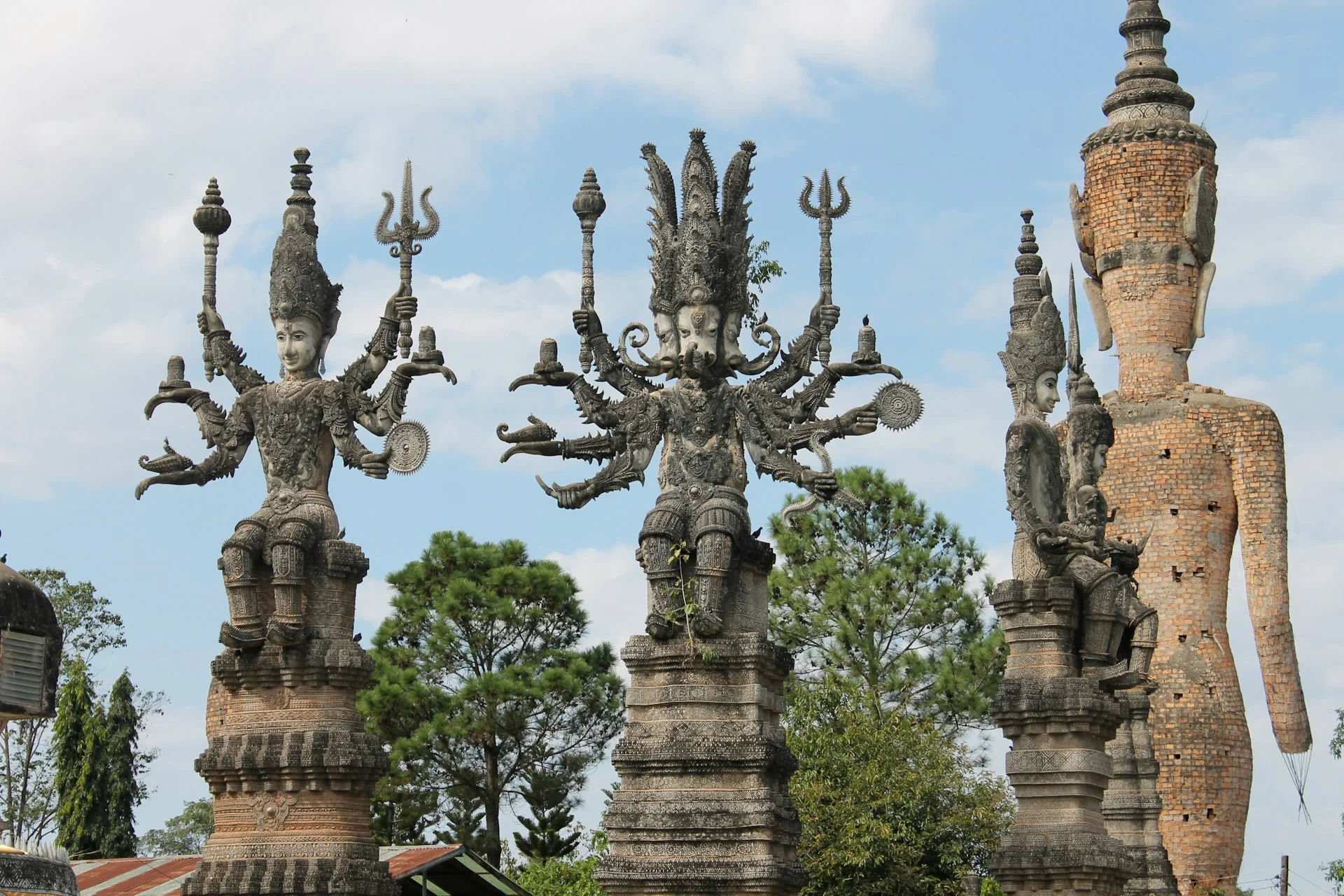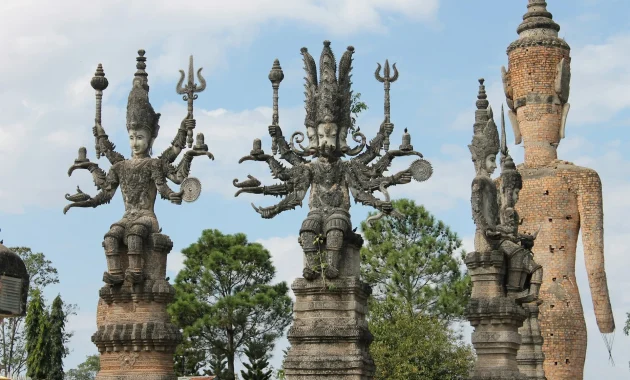
Sala Keoku, located in Nong Khai, Thailand, is an awe-inspiring site that captivates visitors with its intricate sculptures, spiritual essence, and otherworldly ambiance. This hidden gem offers an experience unlike any other, filled with towering statues, mythical figures, and a deep sense of peace. In this comprehensive guide, we explore the wonders of Sala Keoku, detailing its history, unique art, and what makes it a must-visit destination for travelers seeking something extraordinary in Thailand.
History of Sala Keoku: A Visionary’s Dream
Sala Keoku was the brainchild of Luang Pu Bunleua Sulilat, a mystic and spiritual leader whose imagination and beliefs took physical form in this incredible sculpture park. Born in 1932 in Thailand, Bunleua studied under a Hindu sage and fused elements of Buddhism, Hinduism, and animism to create his philosophy. After founding the Buddha Park (Xieng Khuan) in Laos, he relocated to Nong Khai, Thailand, where Sala Keoku was created in 1978.
Bunleua’s vision for Sala Keoku was one of spiritual harmony between various religions and beliefs, uniting them into a singular artistic representation. The park serves as a testament to his conviction, with over 200 sculptures that blend themes from Buddhist, Hindu, and animistic traditions. His dedication and unique perspective are carved into each figure, making Sala Keoku a living representation of his spiritual journey.
The Sculptures: A Blend of Religions and Mythology
Sala Keoku is most famous for its gigantic sculptures, many of which tower over visitors at heights of up to 25 meters (82 feet). Each statue tells a story, often drawn from a mix of Hindu mythology, Buddhist philosophy, and local animist beliefs. Walking through the park, one can encounter mythical creatures, gods, and humans engaged in symbolic poses that reflect the cyclical nature of life, death, and rebirth.
Key Sculptures to Explore
- The Seven-Headed Naga: One of the most impressive pieces in the park is the Seven-Headed Naga, which symbolizes protection and spiritual power. This immense serpent is an iconic figure in Buddhist and Hindu traditions, believed to guard sacred spaces.
- Buddha with Multi-Arms: Another standout is the statue of Buddha with multiple arms, reminiscent of the Hindu deity Vishnu. The arms represent the infinite ability to guide and support the universe.
- Wheel of Life: The Wheel of Life is one of the central themes in Sala Keoku, portraying the cycle of birth, suffering, death, and rebirth. Surrounding it are various deities and mythological figures, each symbolizing different stages of the human journey.
Symbolism in Art
The artwork in Sala Keoku isn’t just for show; each statue is filled with rich symbolism. For instance, the multi-headed serpents and bodhisattvas reflect ideas of wisdom, protection, and spiritual growth. Human figures interacting with mythological creatures offer reflections on human nature and the challenges of living a spiritual life. The recurring theme of the Naga serpent demonstrates the significance of this creature in Southeast Asian religions, representing protection, water, and fertility.

The Atmosphere of Sala Keoku: A Spiritual Haven
The feeling you get while wandering through Sala Keoku is not just one of admiration for the art but a deep spiritual connection. The park exudes a sense of tranquility, where the combination of nature and monumental sculptures invites contemplation and introspection. Visitors often report feeling at peace, as if they’ve entered a sacred space that transcends the physical world.
What makes Sala Keoku even more intriguing is that it doesn’t align perfectly with any one religion. Instead, it embraces elements of Buddhism, Hinduism, and local Thai animism, allowing people from various spiritual backgrounds to find something that resonates with them. This creates a unique atmosphere of inclusion, where the barriers between different belief systems seem to dissolve.
Visitor Information: Practical Tips for Exploring Sala Keoku
Location and Accessibility
Sala Keoku is located in the Nong Khai Province of Thailand, close to the border with Laos. The park is situated about 4 kilometers from Nong Khai town, making it easily accessible by car, tuk-tuk, or even bicycle. Many visitors to the region make Sala Keoku part of a larger trip, often combining it with a visit to the famous Friendship Bridge that connects Thailand and Laos.
Best Time to Visit
The best time to visit Sala Keoku is during the cooler months from November to February. The temperatures are more comfortable, making it easier to explore the park’s open spaces and pathways. Early mornings or late afternoons provide the most atmospheric light for photography, with the towering sculptures casting long shadows that enhance their mystical appeal.
Entry Fees and Operating Hours
Sala Keoku is open daily from 7:00 AM to 6:00 PM, giving visitors plenty of time to take in the vast number of sculptures. The entry fee is minimal, typically around 20-40 Thai Baht, depending on the time of year.
How to Explore the Park
Plan to spend at least a couple of hours wandering through the park. While Sala Keoku isn’t vast, there’s plenty to see and take in. Many sculptures have plaques with descriptions, but hiring a local guide can offer deeper insights into the meaning and history behind each creation. Be sure to bring a camera, as the sheer scale and detail of the statues are worth capturing.
What to Bring
While Sala Keoku is an outdoor attraction, Thailand’s weather can be quite unpredictable. It’s advisable to bring sunscreen, a hat, and plenty of water, especially if visiting during the hot season. Comfortable walking shoes are a must, as the park’s uneven terrain can be challenging to navigate.
Why Sala Keoku is a Must-Visit in Thailand
Sala Keoku offers an unparalleled glimpse into the intersection of art, spirituality, and mythology. It is not merely a sculpture park but a sacred space where visitors can connect with deeper, universal themes of life, death, and the nature of the divine. Its unique blend of cultural influences, coupled with its visually stunning statues, makes it a destination that leaves a lasting impression.
Whether you’re a lover of art, a seeker of spiritual insight, or simply someone looking for a tranquil escape from the more tourist-heavy parts of Thailand, Sala Keoku will not disappoint. Its mystical atmosphere, rich history, and intricate artistry ensure that every visit is an unforgettable experience.
For those traveling through Northeast Thailand, a stop at Sala Keoku is a must, providing a rare opportunity to step into a world shaped by a visionary whose art transcends time, culture, and religious boundaries.